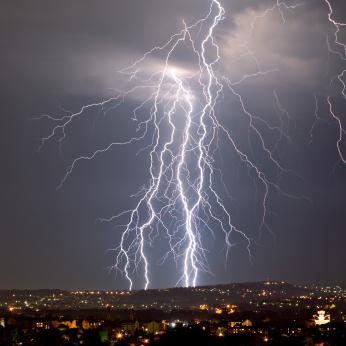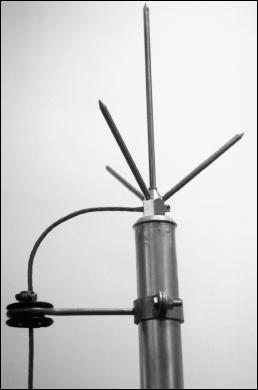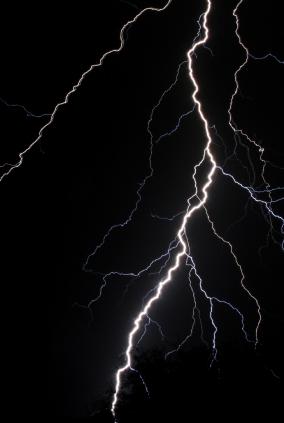 When lighting hits an unprotected house it’s an easy bet on which one will probably win.
When lighting hits an unprotected house it’s an easy bet on which one will probably win.
At 54,000 degrees with a charge of 30 million volts, a bolt of lightning can make chimneys explode, tear holes in a roof and set the place on fire.
Lightning doesn’t even need a direct hit to cause damage. A strike on a transformer, utility line or a nearby tree can still cause a power surge that wreaks havoc on an electrical system and any expensive toys it’s connected to.
While it’s impossible to stop Mother Nature in her tracks, her wrath can be diverted or insulated against. At the very least, the damage she does is covered by a standard homeowner’s insurance policy.
Jean Salvatore, senior vice president for public affairs at the Insurance Information Institute, says whatever damage lightning causes would be covered whether it’s a fried out TV or a devastating fire. That doesn’t mean homeowners can be complacent about protecting themselves from a strike.
“If the lightning causes a fire sure your house burns down, you’re going to be covered for everything in it but you could also be hurt in the fire or even worse, you could be killed, so you also want to think about getting a lightning protection system,” Salvatore says.
Damage caused by lightning cost nearly $1 billion in insurable losses in 2011, according to the I.I.I., with the average claim at $5,112. The average cost per claim rose 93 percent from 2004 to 2011, although the number of claims during that period fell by 33 percent—possibly due to an increasing use of lightning protection systems
“If you’re concerned about this you should call your agent before a lightning storm and say if this would happen what do I need to do, from an insurance perspective or a loss mitigation perspective,” Salvatore says.
She also suggests keeping the receipts for particularly expensive items and making sure the insurance agent is aware of them so they’re properly insured for any loss.
An old TV antenna is not enough
Lightning always tries to find a path to the ground. When a house or another object gets in the way, that’s where problems ensue. Kim Loeher, communications director at the Lightning Protection Institute, says things like wood and brick don’t conduct electricity, so when they’re hit by lightning they tend to ignite or explode.
 To protect against this, an external lightning protection system consisting of air terminals, commonly referred to as lightning rods, can be used to provide a lightning bolt with a safe path to the earth by way of grounding wires.
To protect against this, an external lightning protection system consisting of air terminals, commonly referred to as lightning rods, can be used to provide a lightning bolt with a safe path to the earth by way of grounding wires.
“The lightning protection system is a specified path that takes it underground where it doesn’t do any damage and it’s instantaneous. It’s just like when you turn on your light, you don’t see electricity travel from the switch to the light,” Loeher says. “When lightning hits it just goes to that path, it stays on that path and goes underground and it doesn’t do any damage.”
An old external TV antenna, or even a new digital one, would not be enough. Loeher says air terminals typically need to be spaced every 10 feet, depending on the type of roof, with at least two paths to the ground.
Weathervanes also need to be grounded and are often included as a decorative part of a lightning protection system, although an ordinary weathervane on its own offers no protection.
“If a homeowner says ‘well I’ve grounded my antenna,’ that’s not really going to protect. It might just protect that antenna but it’s not going to protect their home against lightning.” Loeher says.
Grounding a lightning protection system is especially important, with different methods used depending on the type of soil. Loeher says it’s not something homeowners should try to do themselves as it would be like doing a science experiment on their own property—one that could go horribly wrong.
Of course, the worst-case scenario would be if lighting caused a fire but it’s not always obvious that one has happened after a strike. Electrical fires could smolder in a panel box for some time before spreading.
Loeher says flexible metal gas lines, typically found in newer homes, are particularly susceptible to a lightning strike. The metal is so thin that the lightning punctures tiny holes in the gas line which can cause a fire.
When lightning strikes a property it doesn’t always target the roof. A nearby tree, an irrigation system, an electric fence or utility line could become a gateway for a bolt of lightning that strikes one of these objects first and side flashes to the house.
A lightning bolt could also cause a tree to fall onto the house itself. The LPI recommends any tree within 10 feet of a building and taller than the roof have its own lightning protection system.
Air-conditioning units and generators are also susceptible to a strike so a lightning protection system would include this equipment, bonding it to send an electrical surge into the ground.
Multiple layers of protection
Chuck Miccolis, commercial lines engineer at the Insurance Institute for Business & Home Safety, says exterior protection systems are more common on commercial buildings because of the cost, although anyone in a high-risk area may want to consider it.
 He says even if lightning doesn’t side flash or hit a house directly it can still damage the electrical system by causing a power surge, which is a far more likely scenario.
He says even if lightning doesn’t side flash or hit a house directly it can still damage the electrical system by causing a power surge, which is a far more likely scenario.
“A lightning protection system is really the only way to dissipate the electrical energy from a direct strike, but probably more common is a strike hitting nearby that creates a surge in the lines coming into your house,” Miccolis says. “In that instance the best thing you can do is you have multiple levels of protection within your home.”
Miccolis says the first layer of protection would be a whole house surge suppressor, which a utility company can install on the outside of a home and charge the homeowner a monthly fee for its use. Another option would be to have a certified electrician install one inside the house.
Such a system not only protects against lightning, but any power surge regardless of what caused it, such as a malfunctioning transformer or a sudden change in demand on the power grid.
The next level of protection would be surge protectors, which Miccolis recommends for every large piece of electronic equipment. Many people confuse surge protectors with power strips, but they’re not the same. A power strip just turns one outlet into many—it won’t protect that flatscreen TV from getting zapped by a power surge.
A surge protector should be identified as a “transient voltage surge suppressor” that meets UL rating 1449. They range in price from $10 to $50, depending on the level of protection.
“My philosophy is you don’t want to protect a $1,500 television with a $10 surge protector, Miccolis says. “If you get one for $25 you’re going to be much better protected.”
Apart from being rated and certified, Miccolis says there are four key things to look for in choosing a surge protector:
• An indicator light to show that it’s working properly.
• A high number of Joules, a rating number that indicates the amount of energy the surge protector can dissipate. This is the most common factor when choosing a surge protector and they can range from 200 up to several thousand Joules, depending on the price.
• A clamping voltage no higher than 400 volts, which is the level at which the surge protector will conduct electricity to the ground. They’re typically rated at 330 volts.
• A response time of less than one nano second, which is how fast a protector can respond to an electrical surge.
 While putting a surge protector between an outlet and an entertainment system is an obvious choice, Miccolis suggests also using them throughout the house for things like rechargeable power tools and cell phones.
While putting a surge protector between an outlet and an entertainment system is an obvious choice, Miccolis suggests also using them throughout the house for things like rechargeable power tools and cell phones.
This not only protects against an unexpected power surge, it’s also easy to fully safeguard several devices at once by just unplugging the surge protector when there’s a storm.
“The absolute best protection against a power surge coming into your house or business is to unplug your equipment,” Miccolis says. “If you have a power surge protector that has a number of devices on it, you just walk right up and unplug the surge protector and it unplugs everything that you have, but you don’t want to just turn the surge protector off. That’s not going to do it.”
Computers can be hooked up to an uninterruptible power supply, which protects them from a power surge as well as a sudden power loss. If the electricity goes out, a backup power supply can provide enough time to save files and shut down the computer.
Cable lines, telephone land lines and dish antenna feeds also need surge protection and some multi-plug surge protectors allow for this.
Loehr says a lightning protection system for a typical 3,000 square-foot, two-story home would cost around $2,000 to $2,500. The equipment should be UL listed and installed by an LPI certified contractor. A system should be checked every three to five years or any time there’s been construction on the home or after a major storm.
If a surge protector does take a hit, Miccolis says it should be checked to see if the indicator light is working properly and possibly replaced. After a power outage of any kind, he recommends turning off electronic devices, including the air conditioner, to avoid a power surge when the lights come back on.
For more information:
The Insurance Information Institute
Information on lightning protection systems and general lightning safety. http://www.iii.org/articles/lightning-safety.html
The Lightning Protection Institute
Information on lightning protection systems and finding a certified installer. http://www.lightning.org/
The Insurance Institute for Business & Home Safety
Provides information on protecting against all sorts of perils, including lightning. Contains a map showing areas most at risk for lightning strikes in the U.S. http://disastersafety.org/lightning/











